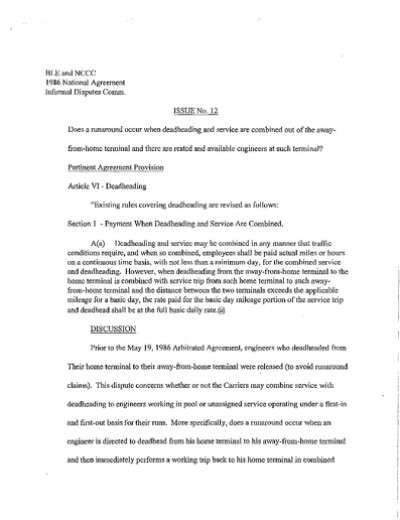DEADHEAD AND SERVICE (FLIPPING CREWS): BLE NAT DISPUTES
| Description:
1986 National Agreement Informal Disputes Comm. ISSUE No. 12 Does a runaround occur when deadheading and service are combined out of the away-from-home terminal and there are rested and available engineers at such terminal? Pertinent Agreement Provision Article VI - Deadheading "Existing rules covering deadheading are revised as follows: Section 1 - Payment When Deadheading and Service Are Combined. A(a) Deadheading and service may be combined in any manner that traffic conditions require, and when so combined, employees shall be paid actual miles or hours on a continuous time basis, with not less than a minimum day, for the combined service and deadheading. However, when deadheading from the away-from-home terminal to the home terminal is combined with service trip from such home terminal to such away-from-home terminal and the distance between the two terminals exceeds the applicable mileage for a basic day, the rate paid for the basic day mileage portion of the service trip and deadhead shall be at the full basic daily rate.@ DISCUSSION Prior to the May 19, 1986 Arbitrated Agreement, engineers who deadheaded from Their home terminal to their away-from-home terminal were released (to avoid runaround claims). This dispute concerns whether or not the Carriers may combine service with The Organization relies on agreed upon Question and Answer No.1 under Article VI, Section 2 which reads: AQ-l: Can a runaround occur when a crew working into the away-from-home terminal is relieved and deadhead home separate from service? A-I: Local runaround rules continue to apply.@ The above Question assumes that the Carrier has elected to separate deadheading from No. 12. Next, the Organization argues that since Arbitration Award No. 458 did not address turnarounds or engineers= order of turn, the local rules survived. An examination of the historical evolution of the rule discloses that the first sentence of Article VI, Section lea) was lifted from Paragraph (a) of Article G-c-l in the BLE Agreement with the Consolidated Rail Corporation. The Conrail Rule also provides that when deadheading is combined with service, away-from-home terminal crews may, be deadheaded without regard to the standing of other crews on the board. (See Paragraph (b) of Article G-c-l.) Put differently, the combination of deadheading with service does not result in running around a rested and available engineer on the Extra List or in a pool. Moreover, the genesis of the Conrail Rule was an almost identical provision on the former Pennsylvania Railroad. The rule, which dates back to 1928, was interpreted to allow deadheading in and out of an away-from-home terminal regardless of whether or not engineers at the away-from-home terminal were rested and available for service. [See the Interpretation Issued by the Pennsylvania Railroad System Joint Reviewing Committee Engine and Train Service Employees.] This interpretation was followed on the former Pennsylvania and then carried forward on the successor line, . Absent a distinguishing interpretation (such as in Issue No. 10), this Committee must affirm the well entrenched past practice emanating from the railroad where the rule originated. Indeed, in agreed upon Question and Answer No. I under Article VI, Section I, the parties contemplated that the new deadheading rule would be applied in a blanket fashion. Even though the Question and Answer addressed the problem of notice, the parties implicitly anticipated that crews could be deadheaded in and out of away-from -home terminals subject only to the notice requirement despite the existence of runaround and first-in, first-out rules on the various railroad properties. In view of the broad Answer to Issue No. 12: No. DATED: May 16, 1988 Larry D. McFather John B. LaRocco Charles I. Hopkins, Jr. |
